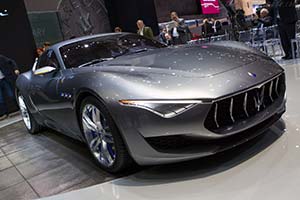
| Maserati Alfieri |
| Article | Image gallery (23) | Specifications |

|
|
Page 1 of 2 Next >> The striking new concept bears the name of Alfieri, the most prominent of the Maserati brothers, and the engineering genius who founded "Officine Alfieri Maserati" in Bologna a century ago. The Alfieri was created at the Maserati Centro Stile in Turin by a small group of talented young designers led by Marco Tencone. The project was masterminded by Lorenzo Ramaciotti. The Alfieri is being unveiled at just the right time to re-establish Maserati's true orientation in terms of design and production. If the new Quattroporte and Ghibli gave the impression that Maserati was becoming oriented towards sporty, upper class four door saloons, this new concept is striking back and reminding everybody that the brand has a remarkable racing heritage and a unique tradition in exotic GT cars. There is no doubt that the Alfieri concept represents the true essence of the Maserati brand. It is a sleek, Italian style 2+2 like the 1957 3500 GT, the 1959 5000 GT and the 1969 Indy before it, and clearly affirms Maserati's racing DNA. Sportier in character than the GranTurismo, the Alfieri boasts proportions that might well be archetypal for a future true sport car and certainly hint at the brand's stylistic intentions for the near future. "Maserati doesn't change. Maserati is always Maserati", as Ramaciotti puts it. As with all concept cars, there is a strong desire to turn the Alfieri into reality. Though not yet at the final prototype stage like tomorrow's grand touring, it has nevertheless been conceived, designed and created in an approach aimed at 100% realism. According to Lorenzo Ramaciotti, "The Alfieri is a transition point between 100 glorious years of history and the future that is opening up before us. I sincerely can't say that we'll see this car in production in two years-time, but I'm certain we'll see something very similar." The development process kicked off last summer. Designers were asked to start from a blank sheet to create a concept for Maserati's centenary. The sketches that would lead to what is now the Alfieri emerged among various other proposals. One of the most fascinating cars of all times, the Maserati A6 GCS-53 designed by Pininfarina in 1954, proved a valuable source of inspiration for the designers. Far more than a rare racing machine for gentlemen drivers, the A6 GCS-53 was a masterpiece of design. It was also the last car that Pininfarina designed on a Maserati model before making a comeback in the first decade of the 21st century with the Quattroporte and the GranTurismo. The A6 GCS-53 was an iconic piece of automotive technology and simply breathtaking for its proportions and design features: a diminutive cabin positioned almost over the rear wheels, a seemingly endless bonnet and long, sinuous wings stretching nearly to the rear wheels. The Alfieri is obviously much more than a futuristic interpretation of the A6 GCS-53. Maserati has a diversified design history that encourages designers to look forward rather than back: "We wanted the Alfieri to test future design paths", Ramaciotti explains. "The car is very aggressive but still sober in style, forceful but understated." The acronym A6 GCS stood for Alfieri 6 cylinder, Ghisa, Corsa, Sport, epithets that well convey its long bonnet, and rear-set 2 cabin. While the inverted A pillars of the A6 GCS-53 were not an option in the new Alfieri, their optical effect has been recreated by a sculptured line that starts from the bonnet and fades to the door high line, making the windscreen look larger. The long, low nose is a stylistic evolution from contemporary Maserati models. The grille is divided vertically into two concave sections that seem to hang in the air. The sleek DRLs are connected by a clear accent line with the iconic "V" motif in the centre. The aggressive headlights incorporate bi-xenon-LED bulbs and are rendered distinctive by a characteristic eyebrow, repeated on the twin exhaust tail pipes. The three dimensional candy-cane tail lights are made up of two red external elements with a white element inside. Their shape harmoniously follows the rear shoulder of the car and complements the air ducts underneath to create an impressive, racing style rear view. The Alfieri's designers have developed a streamlined, uncluttered form where the only decorative elements - the restyled triple air ducts on the wheel arches - are finely integrated. This eye-catching silhouette almost entices you to caress it. The wheels have been specially designed for the Alfieri concept. Forged from single aluminium elements, the 21" diameter rear and 20" front wheels feature integrated decorative spokes that wink at the classic spoke wheels of the 1950s. Though form is the dominant element, colour and detail play a key supporting role. A liquid metal colour called "Steel Flair" has been chosen for this Maserati 100th anniversary concept. This choice of finish gives the Alfieri's elegant shape a refined, technical and contemporary look, as if a metallic veil has been draped over a naked body. The decorative spokes of the forged wheels, the brake calipers, the grille, the iconic triple air ducts, the rear diffuser, the provocative eyebrow of the exhaust tail pipes are all finished in Maserati Blue. The Alfieri signature, retrieved from an old Maserati document and sculpted in the number plate recess on the rear of the car is also in blue. The front bumper spoiler and rear diffuser are in carbon fibre with aluminium inserts. Page 1 of 2 Next >> |
| Article | Image gallery (23) | Specifications |
| All Cars - Contact us - Privacy Statement - Top | © 1998 - 2024 Ultimatecarpage.com |

